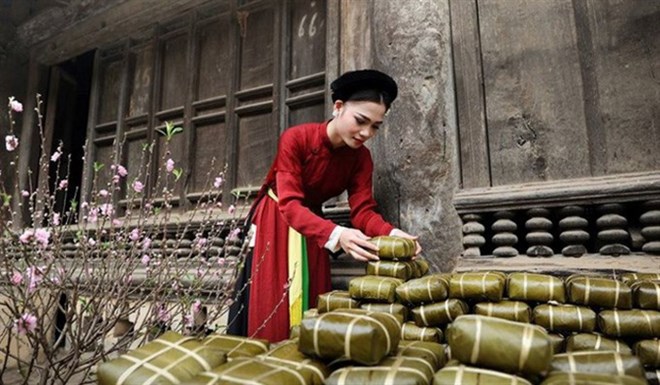



Participants will be able to make sticky rice cakes at the event.
(Photo: truyenhinhdulich.vn)
The event, the fourth of its kind held by Dinh Lang Viet
(Vietnamese Communal House) Group, is forecast to gather thousands of club
members, diplomats, foreign students, international organisations, folk artists
and locals.
Le Mat village’s communal house on the eastern outskirts of Hanoi will provide
a platform to showcase the main activities over the two days.
Before departing for Le Mat village, the organising board and foreign students
will walk around Hang Luoc Flower Market and some relic sites within the Old
Quarter like Bach Ma Temple on Hang Buom Street, the Ancient House at 87 Ma May
Street and Kim Ngan Temple on Hang Bac Street.
The event at Le Mat Communal House will include a ceremony to erect "cay neu” a
tall bamboo tree. The bamboo pole will be stripped of its leaves,
except for a tuft at the top, so that it can be wrapped or decorated with red
paper for good luck. Bows, arrows, bells and gongs will be hung on the
tree with the hope that the bad luck of the past year is chased away and
everyone has a happy New Year.
A traditional ceremony will also be held, as well as calligraphy and folk
singing.
Artisans from host Le Mat village, which specialises in raising snakes, will
perform snake dances.
Artisans from Kim Hoang Folk Painting Village from Hoai Duc district will
perform an ancient genre of painting. Participants will have the opportunity to
cook traditional food such as chung (square, sticky rice cake) and
other traditional delicacies eaten during Lunar New Year.
Both men and women participating in the gathering are encouraged to wear the
Vietnamese traditional long dress.
"The event aims to preserve and develop cultural values among Vietnamese people
and praise the value of communal houses, especially the space around the houses
which has been at risk of fading due to urbanisation and international
integration,” said fine arts critic Nguyen Duc Binh, head of the group.
"Through the annual Tet Viet event, the group wants to teach young people about
traditional cultural values,” he said.
Interested people can register at https://www.facebook.com/groups/DinhlangVN/.
Deadline for registration is January 22, 2019. The group is also calling for
sponsorship and donations.
Le Mat village is located in Viet Hung ward, Long Bien district, Hanoi.
The event last year at So Village’s communal house, in Quoc Oai district, some
20km to the west of Hanoi’s centre, gathered thousands of people including the
group’s members, locals, tourists and representatives from diplomatic
organisations in Hanoi.
Source: VNA